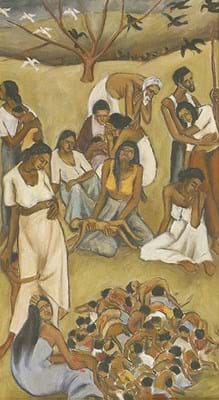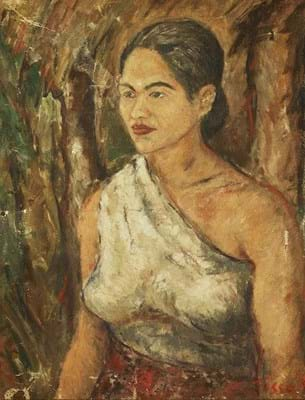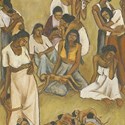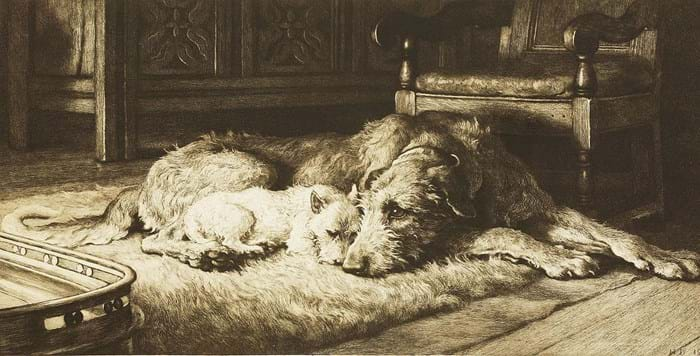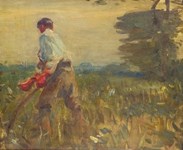Richard Gabriel (1924-2006) was the youngest of the founding members of the famous Colombo 43 Group of Sri Lankan Modernist painters.
Founded in 1943 and spearheaded by the photographer and critic Lionel Wendt (1900-44), the group was key to the promotion of Contemporary art and aesthetic in Sri Lanka, breaking away from the south Asian tradition in favour of European Modernism.
Gabriel’s artistic talents were first spotted in 1943 at The Ceylon War Effort Pictures, a government-sponsored exhibition of paintings where he won 200 rupees for the four paintings he submitted. In 1952 he was awarded a British Council scholarship and received formal training at the Chelsea School of Art.
Over the course of a long career, Gabriel experimented with linocuts and woodcuts, etchings, sculptures and wall murals, all executed in a rural folk style. The artist’s long-time friend and biographer, Neville Weereratne, wrote: “In his work as an artist, Gabriel painted images of his beloved people, the fisherman, the farmer, the mother and her child, all of them in their rich, familiar and beautiful landscape.”
Commercially speaking, Gabriel’s works are more affordable than other founder members such as George Keyt and Justin Deraniyagala, although his large output is found in private collections in his native country, India, Japan and the West, along with Australia, where he emigrated in 2002.
Two religious paintings by Gabriel dating to the 1980s were offered in a Fine Interiors auction at Essex saleroom Sworders (23% buyer’s premium) on September 10-11 from a ‘prominent’ private West Country collector.
Based on the Biblical episode the Massacre of the Innocents, they sold for £3200 and £9000 to a buyer in Sri Lanka. Gabriel had a strong faith and produced many paintings and murals for churches around the country.
Further Sri Lankan works consigned from the same source to Sworders included a 1951 oil on canvas portrait, Rodiya Woman, by Tissa Ranasinghe (b.1925), who is known best for his Giacometti-esque figurative bronzes. The early 23 x 18in (60 x 46cm) oil on canvas, made during his formative years at the College of Fine Arts in Colombo, sold to the same buyer at £4200 against a £300-500 guide.
Two 1980s nudes by Albert Dharmasiri (b.1939), a Sri Lankan academic and who co-authored the 2009 book Sri Lankan Painting in the 21st century, completed the group, selling above estimates for £800 and £1100.
Steele selection
Elsewhere in the sale was a large collection of prints by the English etcher Herbert Thomas Dicksee (1862-1942).
The selection of 30 etchings came from the collection of Bryan and Valerie Steele and was a near sell-out with the majority of lots getting away to total just under £12,000. The Steeles were huge fans of Dicksee’s work and amassed a near-complete collection of his animal etchings.
Dicksee’s love for animals developed during his time at the Slade in London where he studied under Alphonse Legros, the distinguished painter, etcher and sculptor. He would often visit the Zoological Gardens close by in Regent’s Park where he sketched the lions and tigers in their enclosures. Dicksee, who kept numerous dogs as pets, also specialised in sympathetic paintings of hounds which he usually did from life.
Highlights from the group included a signed 12½ x 22in (32 x 56cm) artist’s proof of Comrades depicting a Scottish deerhound and a West Highland terrier printed in an edition of 325 by Frost & Reed in 1928. It made £1200, the top price of the group, against a £200-300 guide.
As well as hounds, big cats featured prominently, with an etching of a Siberian tiger from an edition of 150 achieving £680 against an identical estimate.
Famous Stubbs print
Meanwhile, a copy of the famous George Stubbs (1724-1806) print A Horse Affrighted at a Lion sold well above its £200-300 estimate for £7200 to a gallery in North America. It was one of 12 etchings that Stubbs published in 1788 in an effort to promote his work.
This print, glued to its mount, included a typed label reading: This picture was presented to Sampson Bennett by Mr Spratt, a fellow of St Catherine’s College Cambridge. Mr Bennett had successfully operated upon Mr Spratt’s spaniel.


